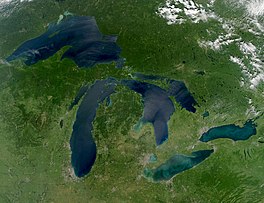
Back Groot Mere Afrikaans Große Seen ALS ታላላቁ ሀይቆች Amharic Grans Lacos d'America d'o Norte AN البحيرات العظمى Arabic ܝܡܡܬܐ ܪܘܪܒܬܐ ARC البحيرات العظيمه ARZ বৃহৎ হ্ৰদসমূহ Assamese Grandes Llagos AST Böyük göllər Azerbaijani
| Great Lakes of North America | |
|---|---|
| Great Lakes | |
 | |
 Bathymetry map of the Great Lakes | |
| Location | Eastern North America |
| Coordinates | 45°N 84°W / 45°N 84°W |
| Type | group of interconnected freshwater lakes |
| Part of | Great Lakes Basin |
| Primary inflows | Past: precipitation and meltwater Now: rivers, precipitation, and groundwater springs |
| Primary outflows | Evaporation, St. Lawrence River to the Atlantic Ocean |
| Basin countries | Canada, United States |
| Surface area | 94,250 square miles (244,106 km2) |
| Average depth | 60–480 ft (18–146 m) depending on the lakes |
| Max. depth | 210–1,300 ft (64–396 m) depending on the lakes |
| Water volume | 5,439 cubic miles (22,671 km3) (lowest) |
| Frozen | around January to March |

The Great Lakes (French: Grands Lacs), also called the Great Lakes of North America, are a series of large interconnected freshwater lakes in the east-central interior of North America that connect to the Atlantic Ocean via the Saint Lawrence River. The five lakes are Superior, Michigan, Huron, Erie, and Ontario, and they are in general on or near the Canada–United States border. Hydrologically, Michigan and Huron are a single body of water joined at the Straits of Mackinac. The Great Lakes Waterway enables modern travel and shipping by water among the lakes.
The Great Lakes are the largest group of freshwater lakes on Earth by total area and the second-largest by total volume; they contain 21% of the world's surface fresh water by volume.[1][2][3] The total surface is 94,250 square miles (244,106 km2), and the total volume (measured at the low water datum) is 5,439 cubic miles (22,671 km3),[4] slightly less than the volume of Lake Baikal (5,666 cu mi or 23,615 km3, 22–23% of the world's surface fresh water). Because of their sea-like characteristics, such as rolling waves, sustained winds, strong currents, great depths, and distant horizons, the five Great Lakes have long been called inland seas.[5] Depending on how it is measured, by surface area, either Lake Superior or Lake Michigan–Huron is the second-largest lake in the world and the largest freshwater lake. Lake Michigan is the largest lake that is entirely within one country.[6][7][8][9]
The Great Lakes began to form at the end of the Last Glacial Period around 14,000 years ago, as retreating ice sheets exposed the basins they had carved into the land, which then filled with meltwater.[10] The lakes have been a major source for transportation, migration, trade, and fishing, serving as a habitat to many aquatic species in a region with much biodiversity. The surrounding region is called the Great Lakes region, which includes the Great Lakes Megalopolis.[11]
- ^ "Great Lakes". U.S. Environmental Protection Agency. June 28, 2006. Retrieved February 19, 2011.
- ^ "LUHNA Chapter 6: Historical Landcover Changes in the Great Lakes Region". USGS: Ecosystems. November 20, 2003. Archived from the original on January 11, 2012. Retrieved February 19, 2011.
- ^ Ghassemi, Fereidoun (2007). Inter-basin water transfer. Cambridge: Cambridge University Press. ISBN 978-0-521-86969-0.
- ^ "Great Lakes: Basic Information: Physical Facts". U.S. Environmental Protection Agency. May 25, 2011. Archived from the original on May 29, 2012. Retrieved November 9, 2011.
- ^ Williamson, James (2007). The inland seas of North America: and the natural and industrial productions ... John Duff Montreal Hew Ramsay Toronto AH Armour and Co. ISBN 9780665341281. Retrieved January 5, 2014.
- ^ "The Top Ten: The Ten Largest Lakes of the World". infoplease.com.
- ^ Rosenberg, Matt. "Largest Lakes in the World by Area, Volume and Depth". About.com Education. Archived from the original on February 17, 2017. Retrieved January 30, 2015.
- ^ Hough, Jack (1970) [1763]. "Great Lakes". Encyclopædia Britannica. Vol. 10 (Commemorative Edition for Expo'70 ed.). Chicago: William Benton. p. 774. ISBN 978-0-85229-135-1.
- ^ "Large Lakes of the World". factmonster.com.
- ^ Cordell, Linda S.; Lightfoot, Kent; McManamon, Francis; Milner, George (2008). Archaeology in America: An Encyclopedia. ABC-CLIO. p. 1. ISBN 978-0-313-02189-3.
- ^ "Great Lakes". America 2050. Archived from the original on February 20, 2020. Retrieved December 7, 2016.